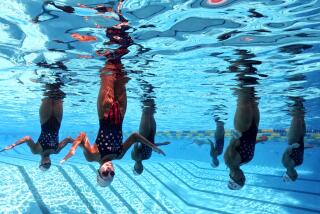String Quartet Tunes Up for Sky-High Competition : Kite flying: A Redondo Beach team has the right moves to qualify for the sport’s world championships.
With parade-ground precision, the four men raced back and forth in the sand at Redondo Beach while one of them barked commands. Adroitly manipulating tethers, they guided four teal-and-black kites streaking in tight formation across the sky.
“Roll it, roll it, roll it! Roll with me, Michael!” the leader shouted, as the kites looped crazy figure-eights more than 100 feet aloft. “Pull, break, turn, ready, turn.”
Kite flying is a breeze for the Tsunami Flight Team, a four-man group that has put Redondo Beach on the world’s competitive kite flying map. The team is one of only two in the United States to qualify for next month’s World Cup Sport Kite Championships in Odawara, Japan.
Executing moves with names such as “whoop-de-do,” “mushroom” and “box-eights,” Tsunami members practice 20 hours a week along the shoreline at Redondo Beach and El Segundo. They spend another 20 hours a week at the Gardena home of team captain Randy Joe, where they work through their routines with flashlights and models and come up with performance-enhancing designs for their kites.
“This isn’t kids’ stuff,” said Joe, 37. “There’s some very serious competition going on.”
Joe and team members Michael Vanca, 35, and Mike Ida, 34, have flown together for the last two years. Raul Brieno, 24, who also flies with a South Bay team named Tempest, became Tsunami’s newest full-time member in May.
The group reflects a diverse range of backgrounds and professions. Joe, who owns a kite store in Redondo Beach, is a third-generation Japanese-American. Vanca is a data processing manager whose parents immigrated to the United States from Germany in 1952. Ida, a salesman who is currently unemployed, was born in Japan but grew up in Hawaii. And Brieno is a manufacturing supervisor at a movie screen production plant whose parents immigrated from Mexico before he was born.
The men have become fast friends, often meeting for dinner or drinks. But their chief bond is kite flying, and since they began devoting much of their free time to the sport in January, they have dramatically honed their skills.
This year the team ascended to the No. 2 spot in the country, behind Top Of The Line Flight Squadron of San Diego. On their way to that ranking, Tsunami won kite flying events in Berkeley, San Diego and Seaside, Ore.
Although millions of people fly kites for recreation in the United States, Tsunami is one of about 200 teams that compete in the sport nationwide. About 15 kite teams compete in Southern California.
Tsunami owns 60 kites, with each set of four costing about $1,500. The most lightweight varieties, about 6 ounces, can fly in 2 m.p.h. breezes. The heaviest kites, weighing about 14 ounces, can weather winds of up to 30 m.p.h.
Although kite flying has been popular in China and Japan for thousands of years, competitive kiting--also called stunt kiting--has more recent origins. Maneuverable, dual-line kites--kites with two tethers--were invented during World War II to serve as practice targets for U.S. Navy antiaircraft gunners. The kites bore painted replicas of Japanese and German planes.
Dual-line kites, however, didn’t attract hobbyists until much later, after fiberglass skeletons and nylon fabrics were introduced into kite manufacturing in the 1970s, said Daniel Prentice, publisher of the San Francisco-based American Kite magazine and founder of the World Cup competition.
When manufacturers joined the newer materials to the World War II-era kite designs, a faster and more maneuverable hobby kite was born. The sport of competitive kiting emerged in 1986 after an official rule guide to govern competitions was published.
Unlike the diamond-shaped silk or paper models that require a running start, the aerodynamically designed kites used in competition rise from the ground with just a few yanks on the tethers. Once airborne, the kites can be guided into intricate maneuvers by manipulating the tether handles.
“Kite flying, as the general public understands it in this country, conjures up images of flying a single-line kite on a warm spring day at a picnic--a relatively passive hobby,” Prentice said. “But when people began using nylon and fiberglass, it began to change the way people think about kites. . . . (The sport) became very dynamic.”
In competition, teams of four to six members fly their kites in three- to five-minute synchronized routines. In so-called ballet events, teams fly their kites to music. In precision events, teams fly compulsory maneuvers that are judged on their execution and degree of difficulty.
Tsunami members are so determined to bring home the Silver Cup from Japan this year that not even Hurricane Darby could keep them away from practice. On a recent evening, although the sky was dark and thick with moisture, the team was busily running through its repertoire on the shore at Redondo Beach.
The men set four teal-and-black kites with eight-foot wingspans in the sand. In the eerie glow of the lampposts along the esplanade, the 14-ounce kites resembled stealth bombers ready for takeoff.
The kites’ thin nylon shells were damp from the mist, and sand had begun to stick to the tethers, which are smooth and thick, like heavyweight fishing line.
A wind meter that Joe keeps tied on a cord around his neck showed a breeze of about 7 m.p.h.--plenty of wind to fly. The men took their places in the sand.
“Stand, ready, pull,” Joe called out as the men jumped into action, jerking their tethers to make the kites rise. “Turn, break--you’re going too flat, Michael.”
Running in the sand, arm muscles straining against the tethers, team members responded instantly to Joe’s commands. They moved in unison, never once bumping into each other as they kept their attention focused skyward.
The kites whirred as they wove patterns in the sky. Practicing one of its signature moves, the team sent its kites hurtling toward a single point in the sky--and apparent collision--only to guide them past each other with inches to spare.
With such displays, the team instantly gained a fan in Carson sixth-grader Aldo Esquivel. After watching the kites for several minutes he declared: “It’s just awesome.”
Kite flier Stan Newman, 40, who had been flying his own dual-line kite nearby, also admired the Tsunami routine.
The Redondo Beach salesman said he enjoyed the way the team seemed to “just dance on the sand,” but added that he hasn’t asked Tsunami for any tips on technique.
“I don’t want to be a kite groupie,” Newman said.
After three hours of practicing their routines, the men began folding up their kites and packing their bags. Because Vanca had to attend his son’s second birthday party on Sunday, they agreed to meet for a practice session the day before.
There were no complaints. Said Brieno: “It’s kind of like an addiction. Once it’s in your blood, you can’t leave it.”


